San Martín de la Vega, Madrid, Spain – Saturday, May 8th, 2010
Parque Warner Madrid is a Six Flags park with more style and less substance. I really cannot think of a more concise way to describe the park that awaits one after walking beneath their pearly stucco Hollywood entrance gates. It’s a logical result: managed by Six Flags from its inception in 2002, they had the task of envisioning an entire park infrastructure from the ground up rather than add to an existing property piecemeal as they’ve done ever since Six Flags over Mid-America was completed, their only competition in Madrid was the generic rides park Parque de Atracciones Madrid, while highly themed competitors on the coast such as successful PortAventura and newly-opened Terra Mítica were snatching up vacationing Europeans looking for a highly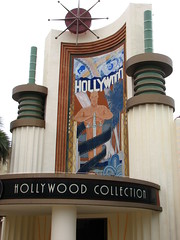 themed adventure experience, it seems only natural that they would try to build their own Islands of Adventure rather than another Magic Mountain on their flat desert plot of real estate, especially as the European canon of amusement places tends to favor detailed thoughtfulness over the loud brashness typical to American parks. (The Islands of Adventure comparison, while applicable to many theme parks opened post-1999, was particularly painful here; note the entry midway leading to a central lagoon with the rest of the globule theme zones strung around the periphery, whimsical children’s section immediately to the right, superheroes on the left…) There was a moment of excited reverie, soon allayed by disenfranchisement as the elaborate Art Deco designs and background big band music along a boulevard inspired by the mesmerizing but dangerous allure of the Golden Age of Hollywood gave away in my psyche with the realization that these were naught but plaster and Styrofoam edifices affixed to a series of warehouses containing overpriced cafeteria food or Looney Tunes knick-knacks. One may ask how they managed such an amazing illusion, but I ask: where is the reality of experience behind it all?
themed adventure experience, it seems only natural that they would try to build their own Islands of Adventure rather than another Magic Mountain on their flat desert plot of real estate, especially as the European canon of amusement places tends to favor detailed thoughtfulness over the loud brashness typical to American parks. (The Islands of Adventure comparison, while applicable to many theme parks opened post-1999, was particularly painful here; note the entry midway leading to a central lagoon with the rest of the globule theme zones strung around the periphery, whimsical children’s section immediately to the right, superheroes on the left…) There was a moment of excited reverie, soon allayed by disenfranchisement as the elaborate Art Deco designs and background big band music along a boulevard inspired by the mesmerizing but dangerous allure of the Golden Age of Hollywood gave away in my psyche with the realization that these were naught but plaster and Styrofoam edifices affixed to a series of warehouses containing overpriced cafeteria food or Looney Tunes knick-knacks. One may ask how they managed such an amazing illusion, but I ask: where is the reality of experience behind it all?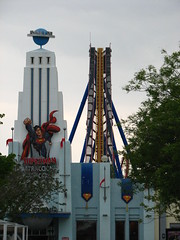
That reality was quickly found in the form of a 164’ tall, seven-inversion B&M floorless roller coaster in the back left corner of the park by the name of Superman: La Atracción de Acero. Right at the entrance this ride displays an identity unique from the American Supermen with detailed queue room themed to the Daily Planet offices, one of those creative touches which is bittersweet because you know that if you actually have time to stop and enjoy the work put into this setting rather than rush right through it, your wait is going to be a very long one. Presumably because building such a showroom that’s actually attached to the coaster structure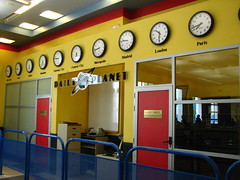 itself would require added engineering headaches so it’s linked by a stretch of chainlink switchbacks, then up a flight of stairs to the more basic station platform given a Superman theme by painting everything primary blue, red and yellow, and having large detailed posters explaining Superman’s abilities (although no effort was made to translate these so one can imagine the biggest thematic purpose they served for a majority of their audience was to assert the cultural dominance of English-language superiority over their own native language. If you’re going to a place built to promote Time-Warner franchises I don’t think
itself would require added engineering headaches so it’s linked by a stretch of chainlink switchbacks, then up a flight of stairs to the more basic station platform given a Superman theme by painting everything primary blue, red and yellow, and having large detailed posters explaining Superman’s abilities (although no effort was made to translate these so one can imagine the biggest thematic purpose they served for a majority of their audience was to assert the cultural dominance of English-language superiority over their own native language. If you’re going to a place built to promote Time-Warner franchises I don’t think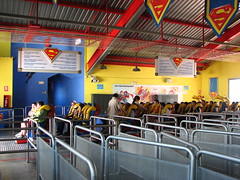 any Spaniards that visit should be surprised by this; English-language themeing was pervasive throughout the entire park for that matter).
any Spaniards that visit should be surprised by this; English-language themeing was pervasive throughout the entire park for that matter).
Thankfully as I one of the first in the morning I got to breeze right up to the air gates and was on the second train out for the day in the front row. A Nitro-esque lifthill configuration scaled back by some 60 feet, the major point where these intros differ is at the top, where Superman still sports that famous pre-drop profile that B&M had rid themselves of a year earlier on Nitro. While I’ve heard numerous hypotheses for why this pre-drop exists, the one I’m most intrigued by is that B&M need to start calculating the heartline on a flat, level piece of track, but they can’t do this at the very top of a lift as the chain mechanisms are still in the way.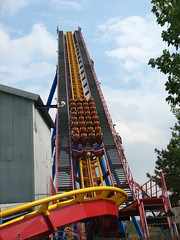 Obviously they realized after Apollo’s Chariot and Raging Bull that on straight drops this wasn’t necessary, so out went the pre-drop for the first time ever on Nitro, but for some reason they decided to keep this quirk a year later on La Atracción de Acero, but I say God bless ‘em for that. This first drop is one of my three favorites on any B&M coaster, the pre-drop affording the front rows a bit of weightlessness on the main descent, while in the back rows it’s solid sustained ejector all the way down to the valley.
Obviously they realized after Apollo’s Chariot and Raging Bull that on straight drops this wasn’t necessary, so out went the pre-drop for the first time ever on Nitro, but for some reason they decided to keep this quirk a year later on La Atracción de Acero, but I say God bless ‘em for that. This first drop is one of my three favorites on any B&M coaster, the pre-drop affording the front rows a bit of weightlessness on the main descent, while in the back rows it’s solid sustained ejector all the way down to the valley.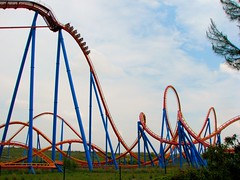
After this good opening they unfortunately regress to their old hackneyed formula of plugging their lineup of big inverting elements one after another to fill out the ride experience with slow, controlled force dynamics (built over a flat arid landscape, no less), but for some reason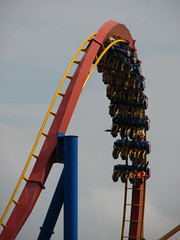 in the front row I didn’t mind it as much. The scale was big enough, the ride smooth and graceful enough, and most importantly the perspective of watching this enormous steel track shred inches beneath my dangling toes with absolutely nothing inhibiting my viewpoint of world rushing around me, was good enough that I couldn’t stop smiling the whole ride through. A vertical loop with a bit of weightlessness at the top offers an extraordinary sense of freedom, as the same goes for the following Immelmann only with an extra twist on the way out.
in the front row I didn’t mind it as much. The scale was big enough, the ride smooth and graceful enough, and most importantly the perspective of watching this enormous steel track shred inches beneath my dangling toes with absolutely nothing inhibiting my viewpoint of world rushing around me, was good enough that I couldn’t stop smiling the whole ride through. A vertical loop with a bit of weightlessness at the top offers an extraordinary sense of freedom, as the same goes for the following Immelmann only with an extra twist on the way out.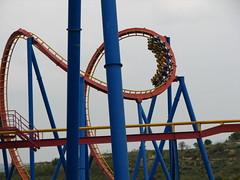
The next element is (surprise!) a zero-G camelback hill, and like the first two maneuvers there’s a supreme sense of the sublime in the front row as you watch the ‘barrel’ of track traced around the heartline unfold before your eyes as you spiral upside-down a hundred feet in the air. It’s particularly effective on the right side of the train, as the track drops and rotates out from under your seat providing the most intense forces on the entire ride. The cobra roll is always interesting in that you get two inversions without having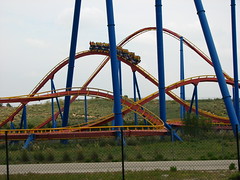 another ground-level valley therefore providing a minor change in pace, plus after five successive inversions there’s a satisfaction to the decadence of so much track laid out ahead.
another ground-level valley therefore providing a minor change in pace, plus after five successive inversions there’s a satisfaction to the decadence of so much track laid out ahead.
The series of wide valleys pulling up into a different maneuver is generally not made better when one of those iterations only culminates in a trim brake, so at the expense of a third-train operation (which would doubtfully be used often anyway; Superman was one-train op all day) the designers wisely decided to keep the flow going with a standard camelback instead. The attempt at weightlessness is a weak one, the hill much lower and more rounded than anything seen on their speed coasters, but it’s infinitely more successful than a pause for a brake run,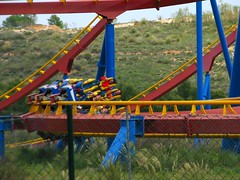 and it’s one of those little differences that breaks the mold enough to make travel to Spain seem at least somewhat worthwhile if you’re going to spend your time riding roller coasters you could otherwise get at home. A standard set of interlocking corkscrews follow, adding more indulgence to the inversion smorgasbord, and then the ride concludes with an extended ground-level figure-eight maneuver. “Ground-level” is the most important term from that description, as those on the lefthand side of the train on the second half can nearly reach down and let their fingers skim across the weeds and tall grass if they so elected. Another treat unique only to this ride. Meager in the grand scheme of formalities this basic layout adheres to, but a treat nevertheless.
and it’s one of those little differences that breaks the mold enough to make travel to Spain seem at least somewhat worthwhile if you’re going to spend your time riding roller coasters you could otherwise get at home. A standard set of interlocking corkscrews follow, adding more indulgence to the inversion smorgasbord, and then the ride concludes with an extended ground-level figure-eight maneuver. “Ground-level” is the most important term from that description, as those on the lefthand side of the train on the second half can nearly reach down and let their fingers skim across the weeds and tall grass if they so elected. Another treat unique only to this ride. Meager in the grand scheme of formalities this basic layout adheres to, but a treat nevertheless.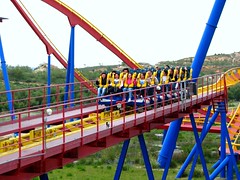
In the end Superman: La Atracción de Acero is far from what I’d call an inspired ride, and indeed one could think of many other ways Parque Warner could have invested the same resources into getting a top-ten, one-of-a-kind layout. But it did manage greater than average success in modern B&M’s one defensible niche which is creating an overwhelmingly large, extravagant and graceful ride experience. That this also constitutes the longest uninterrupted looping layout they’ve ever built also probably aids in its relative success. B&M are unquestionably industry leaders when considered by the merits of Superman and others, but being one of only two steel coaster engineering firms willing to build projects of this magnitude in recent history sort of makes them industry leaders by default. As a side note, competing firms such as Vekoma, S&S, Gerstlauer and Maurer Söhne appear to be getting bigger ideas and bigger contracts with each season so I’m curious to see how B&M will continue to remain competitive especially now that their standard looping formula has finally finished its lifespan. The last floorless coaster built was Hydra in 2005, and the majority of (successful) large custom project in the time since have been diving machines, flying or speed coasters, all outside their traditional mold.
them industry leaders by default. As a side note, competing firms such as Vekoma, S&S, Gerstlauer and Maurer Söhne appear to be getting bigger ideas and bigger contracts with each season so I’m curious to see how B&M will continue to remain competitive especially now that their standard looping formula has finally finished its lifespan. The last floorless coaster built was Hydra in 2005, and the majority of (successful) large custom project in the time since have been diving machines, flying or speed coasters, all outside their traditional mold.
After four or five circuits on Superman I went over to give Batman two rides until the rest of the crowds got there making it no longer a walk-on, so I left to return to the entrance of the park where I hoped to find a reprise from the overcast chill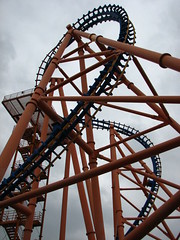 that once again made me regret the decision not to bring along my jacket for the trip. On the way I observed that Stunt Fall appeared to be having start-up problems once starting up the lift but failing and returning to the station, where it was then silently worked upon for the rest of the day. Although I kept checking back, it never opened, representing the one roller coaster in Spain I intended to ride but never did. A shame but not the end of the world, as have been and will continue to be several opportunities back in the US to experience this exact same Vekoma Super Invertigo model in silent inaction as well. I ended up in the Teatro Chino movie theater, which actually would have been a very nice cinema by its own merits, although rather than feature length, theatrically-released films the playbill consists entirely of 3D Looney Tunes 15-minute shorts, which the one I caught featured Marvin the Martian talking in rapid-fire Spanish, for me resulting in a plot only slightly less convoluted than the typical David Lynch opus. A meal at an establishment named Valentino’s yielded unspectacular results, although I now know that “champiñones” will get me mushrooms when ordering a pizza in Spain.
that once again made me regret the decision not to bring along my jacket for the trip. On the way I observed that Stunt Fall appeared to be having start-up problems once starting up the lift but failing and returning to the station, where it was then silently worked upon for the rest of the day. Although I kept checking back, it never opened, representing the one roller coaster in Spain I intended to ride but never did. A shame but not the end of the world, as have been and will continue to be several opportunities back in the US to experience this exact same Vekoma Super Invertigo model in silent inaction as well. I ended up in the Teatro Chino movie theater, which actually would have been a very nice cinema by its own merits, although rather than feature length, theatrically-released films the playbill consists entirely of 3D Looney Tunes 15-minute shorts, which the one I caught featured Marvin the Martian talking in rapid-fire Spanish, for me resulting in a plot only slightly less convoluted than the typical David Lynch opus. A meal at an establishment named Valentino’s yielded unspectacular results, although I now know that “champiñones” will get me mushrooms when ordering a pizza in Spain.
I moved into Cartoon Village where two family coasters and an interactive dark ride awaited me as attractions big enough to be worth my while. The first was Correcaminos Bip, Bip, a Mack YoungSTAR coaster identical to the Pegasus at Europa-Park and also one of the few major post-2002 expansions in the park. Like the ride in Germany it’s a decently fun coaster with some high banking, steep drops, and fast, smooth helices thrown in along with a pop of airtime or two in the back rows. The Wiley Coyote theme fits well with the desert environment and overall seems like a good expansion for the Cartoon Village and Parque Warner in general. It was worth an immediate re-ride when I was done. Nearby was the smaller Tom y Jerry roller coaster, a Zierer Tivoli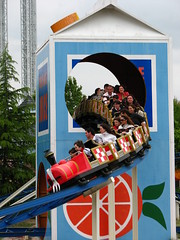 Large model coaster with an ant’s perspective of a picnic setting, including track threaded twice through a giant orange juice carton. The twenty-car train was the most interesting feature about this ride, as a seat far enough to either extreme of the train (I somehow managed the front row) can result in the car accelerating uphill or slowing down on the drops,
Large model coaster with an ant’s perspective of a picnic setting, including track threaded twice through a giant orange juice carton. The twenty-car train was the most interesting feature about this ride, as a seat far enough to either extreme of the train (I somehow managed the front row) can result in the car accelerating uphill or slowing down on the drops,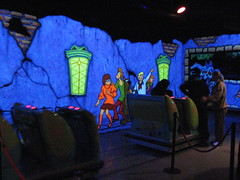 all without any extra influence besides gravity. Finally La Aventura de Scooby Doo rounded out my experience with this section, with was a standard Sally dark ride interactive shooter similar to the ones installed at the former Paramount Parks with ghastly, psychedelic neon glowing sets, surely making one wonder what special 60’s ingredients must be found in Scooby Snacks to make them so addictive.
all without any extra influence besides gravity. Finally La Aventura de Scooby Doo rounded out my experience with this section, with was a standard Sally dark ride interactive shooter similar to the ones installed at the former Paramount Parks with ghastly, psychedelic neon glowing sets, surely making one wonder what special 60’s ingredients must be found in Scooby Snacks to make them so addictive.
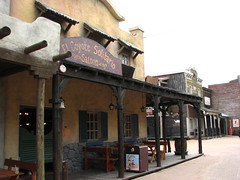 The Old West Territory is an idiosyncrasy in Parque Warner’s thematic line-up, as it neither replicated the setting of movie studios or Hollywood representing Warner Brother’s heritage, nor did it have any specific tie-in to any of Warner’s properties. As close as I could tell it was just there because every red-blooded European theme park needs to have an old western theme section, goddammit. Presumably because the western genre is a staple of filmmaking although if there were any references to The West as a cinematic icon via Ford, Hawks, Sturges, Peckinpah or Leone, I evidently missed them and only saw The West as a theme zone unto itself (though I forget, the Morricone whistle may have been heard over the loudspeakers a couple times). There are a couple of important rides here, the first up being Coaster Express.
The Old West Territory is an idiosyncrasy in Parque Warner’s thematic line-up, as it neither replicated the setting of movie studios or Hollywood representing Warner Brother’s heritage, nor did it have any specific tie-in to any of Warner’s properties. As close as I could tell it was just there because every red-blooded European theme park needs to have an old western theme section, goddammit. Presumably because the western genre is a staple of filmmaking although if there were any references to The West as a cinematic icon via Ford, Hawks, Sturges, Peckinpah or Leone, I evidently missed them and only saw The West as a theme zone unto itself (though I forget, the Morricone whistle may have been heard over the loudspeakers a couple times). There are a couple of important rides here, the first up being Coaster Express.
This is not a coaster to be underestimated. Although ‘only’ 120 feet tall, the immensity of the dense support structure towering over the midways is commensurate with earlier wooden behemoths such as Mean Streak, the Texas Giant or White Cyclone. It is probably of little surprise then that Coaster Express shares about the same level of affection as those installations. The choice to accept the bid put forth for this project by the Roller Coaster Corporation of America (RCCA, the same company responsible for committing Son of Beast as well as numerous other crimes against humanity) was probably not a wise one given their past history of ‘successes’, and the results do not upset that standard before even stepping into the queue: overdrawn and elongated by even RCCA standards, the layout thinks it can use a tremendous scale to mask a phobia to pitch the cars to any angle greater than 45 degrees or a transition length longer than half a football field, for fear that such extreme dynamics might accidently cause their riders brain damage… which would be a tragedy indeed because their horribly sloppy trackwork couldn’t be the sole causation of that accomplishment.
RCCA standards, the layout thinks it can use a tremendous scale to mask a phobia to pitch the cars to any angle greater than 45 degrees or a transition length longer than half a football field, for fear that such extreme dynamics might accidently cause their riders brain damage… which would be a tragedy indeed because their horribly sloppy trackwork couldn’t be the sole causation of that accomplishment.
I actually have to wonder if the problems with roughness might in fact be the fault of Intamin rather than RCCA, as inspection of the track seemed to indicate fairly smooth and competent craftsmanship. Meanwhile it was the rigid and heavy vehicle frames with their hip-hugging t-bar restraint (identical to their steel megacoasters) that seemed to be causing most of the bumping between track and wheel (and consequently seat and rider), something I’d imagine a lighter, more flexible car with less direct contact area between the people and their restraint might have fixed. And in reality, the ride is not that rough. I realize I say this about nearly every ignominious tooth-chipper that I cross paths with, from Son of Beast to Mean Streak, and from Vekoma SLCs to B&M stand-ups. But I rode it at least four or five times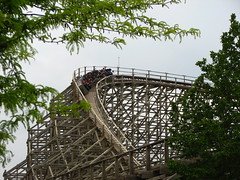 throughout the day, and by those last rides it was because I wanted to experience one last time during the day before I’d miss the opportunity to ever try it again in my lifetime.
throughout the day, and by those last rides it was because I wanted to experience one last time during the day before I’d miss the opportunity to ever try it again in my lifetime.
The layout still sucks though. I’m not even going to bother analyzing it piece by piece to highlight how toothless and slowly timed every element and transition is, or how pointless the progression is, RCCA just play-acting what they think a real wooden coaster would look like rather than taking the effort to create a real coaster for themselves. It has the hills, turns, and profile to look like a convincingly good coaster on the ground,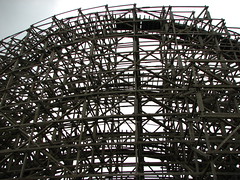 why worry ourselves with what it’s like on ride?
why worry ourselves with what it’s like on ride?
But actually, past the appearances that it doesn’t do anything, it is a sort of strange layout. Off the top of my head I can’t think of any other wooden coaster whose first drop consists of a long, relatively shallow descending helix, or that spends so much time meandering nearly a hundred feet in the air, content to not rush onto the next thing and just continue placidly at its slow and steady wins the race pace. The lower, high-speed sections of the layout could be sufficiently intense just by virtue that any high-speed section of track doesn’t feel safe with this track and trains. And by my last couple of circuits I was able to appreciate a distinct, almost existential quality unique from other coasters… the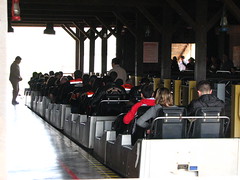 ability to experience what it means to be a wooden roller coaster in its most basic form, distilled from the distractions of constantly changing elevations and forces… resolutely moving forward without any goal intended for its elements to accomplish… simply existing as a set of cars rattling along at varying velocities over steel laminated wooden rails, no greater purpose needed to validate the experience. I think if an enthusiast can walk away from Coaster Express having taken something, anything away from this experience, they have answered one of the many fundamental questions of why one chooses to live, and ride roller coasters.
ability to experience what it means to be a wooden roller coaster in its most basic form, distilled from the distractions of constantly changing elevations and forces… resolutely moving forward without any goal intended for its elements to accomplish… simply existing as a set of cars rattling along at varying velocities over steel laminated wooden rails, no greater purpose needed to validate the experience. I think if an enthusiast can walk away from Coaster Express having taken something, anything away from this experience, they have answered one of the many fundamental questions of why one chooses to live, and ride roller coasters.
This still doesn’t excuse RCCA for making what would otherwise be a totally shitacular roller coaster.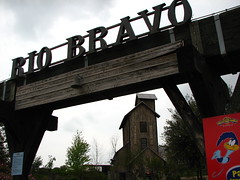
Apart from some of flat rides the Old West Territory’s other main highlight is the Rio Bravo, a large themed water flume ride. This represents a further piece of evidence in my case that in general Europeans do better water rides than Americans, where the focus on a long layout with original designs and settings that one can simply hop on and enjoy without worrying about the consequences takes precedence over concrete channels with a re-creation of Niagara Falls positioned over every other cave mouth. It opens with a climb into a tunnel bore into the large rock monument, where at the top awaits a secret turntable I was not expecting, sending the boat down a first splashdown backwards. After navigating a corner it rolls up onto another turntable to reorient ourselves forward, where it takes a long, leisurely float through canyons,
ourselves forward, where it takes a long, leisurely float through canyons,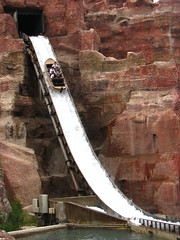 an Indian village and a ghost town before another lift takes us to the highest level of the sandstone mountain, where as predicting the big soaking final drop is encountered, although thankfully due to the cool weather it was not very wet. See, Cedar Point, this is how you build a proper western-themed log flume! It was also entertaining while in line to join the rest of the station in a loud chant with the operator of “lleve al niño fuera de la cerca,” to try to attract the attention of an oblivious mother across the splashdown pool whose child was sitting on top of the protective fence. After five minutes of this she finally
an Indian village and a ghost town before another lift takes us to the highest level of the sandstone mountain, where as predicting the big soaking final drop is encountered, although thankfully due to the cool weather it was not very wet. See, Cedar Point, this is how you build a proper western-themed log flume! It was also entertaining while in line to join the rest of the station in a loud chant with the operator of “lleve al niño fuera de la cerca,” to try to attract the attention of an oblivious mother across the splashdown pool whose child was sitting on top of the protective fence. After five minutes of this she finally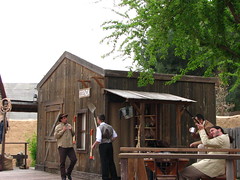 removed the child from the precarious post.
removed the child from the precarious post.
Later in the afternoon I took the time to catch a Wild West show featuring actors, stunts and dance. I believe this may have been a period stage adaption of Milan Kundera’s The Unbearable Lightness of Being, but as I wasn’t able to keep up with the Spanish so it could have also just been about the good cowboys fighting the bad cowboys to get the pretty girl. Once the show had dispersed and a light drizzle was beginning to open up, I ventured into the DC Super Heroes World and decided it a good time to check out Batman: La Sombra del Murciélago, a simulator ride with a couple preshows making the whole experience last a good twenty minutes, and on the whole was one of the better simulators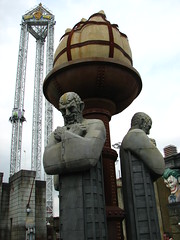 I’ve experienced (not that I go out of my way to experience these attractions). The ride took heavy influence from the narrative and aesthetic of the original Tim Burton Batman, and I’d bet a few Euros that blueprints and film originated elsewhere in the world during the 90’s back when simulators were still thought to be ‘the next big thing’ for amusement parks, as there was some of that special type of kitsch to it that nevertheless made me feel a bit nostalgic.
I’ve experienced (not that I go out of my way to experience these attractions). The ride took heavy influence from the narrative and aesthetic of the original Tim Burton Batman, and I’d bet a few Euros that blueprints and film originated elsewhere in the world during the 90’s back when simulators were still thought to be ‘the next big thing’ for amusement parks, as there was some of that special type of kitsch to it that nevertheless made me feel a bit nostalgic.
Although my day consisted of making several laps of the park and thus these next attractions were sampled sometime prior to the previously described events, I shall explicate about them now to retain continuity of working counter-clockwise around the midway layout. La Venganza del Enigma is a Riddler-themed S&S triple-combo tower standing as a centerpiece icon to the park, one which I never made it around to trying because its restricted operations meant a longer queue than I found acceptable to wait for a ride where a larger model I’m familiar and bored with at my home park and the only distinguishing characteristic here was a change of scenery, which given that Parque Warner is sort of out in the middle of nowhere  in the desert I didn’t predict to be anything spectacular. I did however manage a cycle on the Lex Luthor Invertatron, a standard HUSS Top Spin that started off with a promising program, but then ended after what barely seemed to be a minute of action. A bit further around the corner was Hotel Embrujado in the Studios theme section, a Vekoma Madhouse dark ride/show that successfully covers all the basics: sit on a long bench, the walls and ceiling of the room rotate on a drum giving the perspective that the passengers are being turned upside down, while meanwhile various lighting and special effects go off. A trick involving a ‘transformation’ of the food laid out on the table before us did surprise me for several moments before I managed to figure it out, and overall the set design made it a peer to Disney’s Phantom Manor.
in the desert I didn’t predict to be anything spectacular. I did however manage a cycle on the Lex Luthor Invertatron, a standard HUSS Top Spin that started off with a promising program, but then ended after what barely seemed to be a minute of action. A bit further around the corner was Hotel Embrujado in the Studios theme section, a Vekoma Madhouse dark ride/show that successfully covers all the basics: sit on a long bench, the walls and ceiling of the room rotate on a drum giving the perspective that the passengers are being turned upside down, while meanwhile various lighting and special effects go off. A trick involving a ‘transformation’ of the food laid out on the table before us did surprise me for several moments before I managed to figure it out, and overall the set design made it a peer to Disney’s Phantom Manor.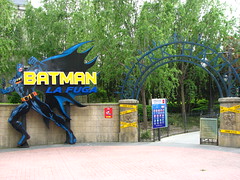
As it began to approach the final hours of my stay in the park I made my way over to Batman: La Fuga, the park’s B&M inverted Batman clone. Not entirely identical to the Batmen: The Rides across the pond, this one features a seven rather than an eight car train, and also slightly larger themed buildings in the queue and the station. The look of the creative design here seems to take a lot more inspiration from the comics than it does any of the films, with lots of airbrushed cartoon murals on the walls of what I think is supposed to be Arkham Asylum, although like Superman once you get to the actual station it’s just plain walls with villain’s faces painted on them.
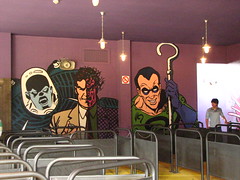 I will forgo providing a full analysis of the ride because there’s nothing about La Fuga that I found significantly different from the original The Ride near Chicago, although the lack of some of the close calls with trees and landscaping in the second half of the spaghetti corkscrew bowl was somewhat missed. The ride was nearly walk-on all day, especially later in the evening when most of the morning crowds started to go home. One cute moment came when there was no wait for any rows when I arrived
I will forgo providing a full analysis of the ride because there’s nothing about La Fuga that I found significantly different from the original The Ride near Chicago, although the lack of some of the close calls with trees and landscaping in the second half of the spaghetti corkscrew bowl was somewhat missed. The ride was nearly walk-on all day, especially later in the evening when most of the morning crowds started to go home. One cute moment came when there was no wait for any rows when I arrived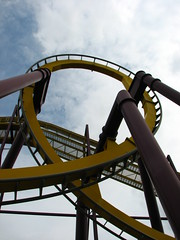 at the platform so I took a position for the front. Moments later a group of four young teen friends arrived in the station and upon discovering it empty excitedly made their way for the front, only to find me where they then assumed the second row. Sensing their disappointment, I quickly made an offer in broken Spanish mixed with English that they could take my seat and I would enjoy the back. Happily they took this offer, and as I left for the back row I heard them excitedly conferring amongst themselves before they collectively decided the English for “gracias” was “thank you”, which they yelled across the station to me. Aw, didn’t that just warm the cockles of my heart?
at the platform so I took a position for the front. Moments later a group of four young teen friends arrived in the station and upon discovering it empty excitedly made their way for the front, only to find me where they then assumed the second row. Sensing their disappointment, I quickly made an offer in broken Spanish mixed with English that they could take my seat and I would enjoy the back. Happily they took this offer, and as I left for the back row I heard them excitedly conferring amongst themselves before they collectively decided the English for “gracias” was “thank you”, which they yelled across the station to me. Aw, didn’t that just warm the cockles of my heart?
Anyway, secured in the back row, we completed a cycle, and noting that no one else had arrived to take that seat, I checked with the operators if I could stay on and they indicated yes. So I went around again,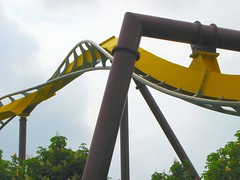 and again, and eventually moved to let others into the back. And I just kept going around for over an hour, between as the rain drizzled on and off and the crowds thinned while the overcast sky grew a darker shade of gray. I had contemplated catching the Batman stunt show nearby but I honestly lost track of time in my seemingly endless marathon that when I finally decided I had enough it was well past the show’s finale. If I lamented at Great Adventure and commented at Great America that my relationship with the Batman layout was not one of great familiarity due to the presence of hour-long queues whenever I visit a Six Flags park, I can certainly say that I became well acquainted with this coaster’s every movement while in Spain.
and again, and eventually moved to let others into the back. And I just kept going around for over an hour, between as the rain drizzled on and off and the crowds thinned while the overcast sky grew a darker shade of gray. I had contemplated catching the Batman stunt show nearby but I honestly lost track of time in my seemingly endless marathon that when I finally decided I had enough it was well past the show’s finale. If I lamented at Great Adventure and commented at Great America that my relationship with the Batman layout was not one of great familiarity due to the presence of hour-long queues whenever I visit a Six Flags park, I can certainly say that I became well acquainted with this coaster’s every movement while in Spain.
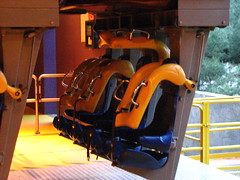 Slightly less than an hour left before the 9:00pm closing, I hurried over to Superman, where once again I observed an open re-ride policy in an oft-empty station. While the skies were dry for the first half of the marathon, when the sun had fully set such that only the distant lights of a major European metropolis illuminated the horizon, a steadier and more persistent rainfall began in the last twenty minutes. Getting damp and shielding my face from the 60mph rain drops on one go-round twenty minutes prior to park closure, I swore five or six times over that this would be my final ride, yet whenever I got back to the station my reasoning followed that there were still a lot of perfectly good empty seats to try out, and even if the rain was increasing I was only going to get marginally more wet than I already was. Plus I was not going to let any of the handful of local Spaniards that had joined me in this seemingly manic quest for as many laps as we could accumulate outlast me. So onboard I stayed until the second to last ride of the night,
Slightly less than an hour left before the 9:00pm closing, I hurried over to Superman, where once again I observed an open re-ride policy in an oft-empty station. While the skies were dry for the first half of the marathon, when the sun had fully set such that only the distant lights of a major European metropolis illuminated the horizon, a steadier and more persistent rainfall began in the last twenty minutes. Getting damp and shielding my face from the 60mph rain drops on one go-round twenty minutes prior to park closure, I swore five or six times over that this would be my final ride, yet whenever I got back to the station my reasoning followed that there were still a lot of perfectly good empty seats to try out, and even if the rain was increasing I was only going to get marginally more wet than I already was. Plus I was not going to let any of the handful of local Spaniards that had joined me in this seemingly manic quest for as many laps as we could accumulate outlast me. So onboard I stayed until the second to last ride of the night,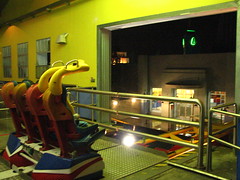 and while one of the attendants tried to get me to stay on for just one more I insisted I finally had enough, and I didn’t want to be late for my train.
and while one of the attendants tried to get me to stay on for just one more I insisted I finally had enough, and I didn’t want to be late for my train.
Ultimately, while I wouldn’t call it the best roller coaster in Spain, Superman may have become my secret favorite based on this experience alone. In fact, riding Superman over and over and over as the increasingly dense rain reflected a hazy twilight glow from the city as we deliriously roared over the dark, empty desert, may have become my single most-cherished memory from my entire ten days of travel in Spain. Whatever shortcomings it might have, as I kicked back and dried off on the Renfe train service back to city I felt as satiated about my day at Parque Warner Madrid as I felt wet.
Satiated and Saturated! I love it. Thanks for posting!
Reading this in The Future as a European, it’s tragicomic that you compare Coaster Express to Mean Streak, Texas Giant and White Cyclone, knowing what happened to those three rides in the meantime that has notably NOT happened to the now SBNO Coaster Express. Surely Parque Warner is one of the most neglected major parks in Europe. Basically no major investments since opening day, twenty years ago? Hard to believe they are in the same group as Kennywood.